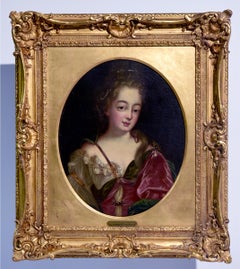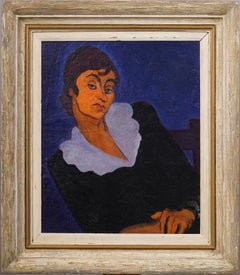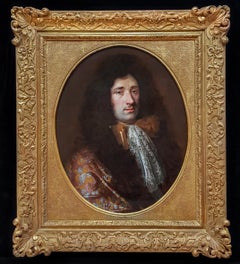(circle of) Nicolas de Largillierre Art
French, 1656-1746
Nicolas de Largillière or de Largillierre (Paris, 10 October 1656 - Paris, 20 March 1746) was a French painter.
Raised in Antwerp, where his family had moved in 1659, it was in the Flemish city that he began his apprenticeship in the workshop of Antoine Goubeau starting in 1668, mainly influenced by Rubens and the Flemish masters. [He entered the guild of the Sint-Lucasgilde as master of the city in 1674.
From 1675 to 1679 he traveled to England, where he approached the Vandyckian painter Peter Lely and was noticed by King Charles II. He will return there in 1685 to paint a portrait of the new King James II.
Returning to France, after 1689 he became one of the most sought-after painters, both for official ex-votos or allegories, and for orders of portraits by the nobility and the upper middle class. Nicolas de Largillière was, together with Rigaud, the portrait painter of the Regency era. He also proved to be a brilliant painter of still lifes, following the Flemish school.
To the solemnity of the gesture of the person portrayed he combined an uncommon search for minute details.
In 1686 he was admitted to the Académie royale de peinture et de sculpture, becoming a professor in 1705 and directing it from 1736 to his resignation in 1743.
Among his most important works we can mention: Portrait of Elizabeth Beaubarnais (Museum of Grenoble); Young Man as Diana (Louvre Museum); Ex-voto in Sainte-Geneviève (church of Saint-Étienne-du-Mont, Paris); Family portrait of Louis XIV (Wallace Collection); Portrait with the family (Louvre Museum).to
1
Overall Width
to
Overall Height
to
1
1
1
1
1
1
1
1
1
1
1
1
9,989
2,754
1,377
1,375
1
1
Artist: (circle of) Nicolas de Largillierre
"Mme de Noirmont", Oil on Canvas Portrait, circa 18th Century
By (circle of) Nicolas de Largillierre
Located in Detroit, MI
This painting titled "Mme de Noirmont" is an oil on canvas work from the studio of Nicolas de Largilliere, one of the most prolific and esteemed French portrait painters of the 18th ...
Category
18th Century (circle of) Nicolas de Largillierre Art
Materials
Canvas, Adhesive, Oil
Related Items
Antique American School Post Impressionist Modern Portrait Framed Oil Painting
Located in Buffalo, NY
Antique American school modernist portrait painting. Housed in a period frame. Measuring 29 by 33 inches overall and 20 by 24 painting alone.
Category
1930s Modern (circle of) Nicolas de Largillierre Art
Materials
Canvas, Oil
$1,775
H 33 in W 29 in D 2 in
Italian Greyhound and Friends - Italian 17thC Old Master dog art oil painting
By Francesco Fieravino
Located in Hagley, England
This stunning Old Master 17th century oil portrait painting is attributed to Francesco Fieravino, an artist famous in his day for still lifes and carpets. This painting which dates t...
Category
17th Century Old Masters (circle of) Nicolas de Largillierre Art
Materials
Canvas, Oil
$56,562 Sale Price
20% Off
H 27 in W 33 in D 2 in
19th Century By Giuseppe Molteni Portrait of a Woman Oil on Canvas
Located in Milano, Lombardia
Giuseppe Molteni (Affori (Milano), Italy, 1800 - Milano, Italy, 1867)
Title: Portrait of a Woman
Medium: Oil on canvas
Dimensions: without frame 67 × 55 cm - with frame 91.5 x 80 cm
...
Category
19th Century Old Masters (circle of) Nicolas de Largillierre Art
Materials
Canvas, Oil
$26,325 Sale Price
20% Off
H 26.38 in W 21.66 in D 1.97 in
Historically Important American Army Soldiers in Paris Cafe WPA Ashcan Painting
Located in Buffalo, NY
Antique American oil painting. Oil on canvas. Measuring 18 by 22 inches.
Category
1930s Modern (circle of) Nicolas de Largillierre Art
Materials
Canvas, Oil
$1,475
H 22 in W 18 in D 2 in
Vintage American Modernist Framed Abstract Portrait Oil Painting
By Chuck Close
Located in Buffalo, NY
American modernist abstracted portrait oil painting in the style of Chuck Close. Framed. Oil on paper. Image size, 23H by 20L.
Category
1990s Abstract (circle of) Nicolas de Largillierre Art
Materials
Canvas, Oil
Pere Creixams Spanish Woman, Oil on Canvas
By Pere Créixams Picó
Located in Saint Amans des cots, FR
Oil on canvas by Pere Creixams Pico (1893-1965), School of Paris, ca.1920. Beautiful Spanish woman. Provenance: Charpentier Gallery, 76 rue du Faubourg Saint Honore, Paris (Sotheby's...
Category
1920s Modern (circle of) Nicolas de Largillierre Art
Materials
Canvas, Oil
$4,000
H 24.81 in W 19.49 in D 2.96 in
Exhibited RSA 1862 Portrait of Girl with Dogs Blossom and Bob
By Gourlay Steell
Located in Hillsborough, NC
Portrait of Girl and Dogs is signed and dated 1861 and exhibited in 1862 is by Gourlay Steell, (1819-1894) RSA, appointed as Animal Painter for Scotland to Queen Victoria’s Court aft...
Category
1860s Victorian (circle of) Nicolas de Largillierre Art
Materials
Canvas, Oil
$10,000 Sale Price
20% Off
H 25.5 in W 31 in D 3 in
20th Century Oil on Canvas Italian Religious Painting Saint Roch with Dog, 1930
Located in Vicoforte, IT
Great Italian painting from the first half of the 20th century. Artwork oil on canvas, on the first canvas, depicting a religious subject Saint Roch with dog and stick of good pictor...
Category
1930s (circle of) Nicolas de Largillierre Art
Materials
Canvas, Oil
$4,157
H 55.12 in W 42.52 in D 1.97 in
Enjoying Old Times
Located in Fredericksburg, VA
"Enjoying Old Times" by Charles Baker captures a poignant and joyful moment in the life of an older man, immersed in the beauty of nature. The painting features the man in the midst of a hike, his weathered walking stick in one hand, and a bottle of champagne in the other. His gaze is fixed on the bottle, a focused and content expression playing on his lips, suggesting a celebration of memories or perhaps a spontaneous toast to the present moment.
Baker’s use of warm, earthy tones highlights the natural surroundings, with the man standing against a backdrop of greenery, a rocky path, and a clear, open sky. The composition is rich in detail, from the rugged texture of the man’s clothes...
Category
Mid-19th Century Hudson River School (circle of) Nicolas de Largillierre Art
Materials
Canvas, Oil
Portrait of A Man Wearing A Top Hat , attributed to Tom Roberts 1888
By Tom Roberts
Located in Gavere, BE
Portrait of A Man Wearing A Top Hat , attributed to Tom Roberts 1888
Thomas William Roberts ( 1856 – 1931) was an English-born Australian artist and a key member of the Heidelberg S...
Category
1880s Realist (circle of) Nicolas de Largillierre Art
Materials
Gold Leaf
$8,422
H 36.23 in W 30.71 in D 3.94 in
'The White Bonnet', Paris, Royal Academy of Fine Arts, Copenhagen Art Museum
By Henrik Schouboe
Located in Santa Cruz, CA
Initialed lower left, 'H.S.' for Henrik Schouboe (Danish, 1876-1949) and painted circa 1915.
Henrik Schouboe first studied at the Copenhagen's Royal Academy of Fine Arts from 1894-1...
Category
1910s (circle of) Nicolas de Largillierre Art
Materials
Canvas, Oil
$4,500
H 20.25 in W 18.75 in D 0.75 in
Four large French family portraits
Located in BELEYMAS, FR
Suite of four large family portraits, kept together to this day. Created around 1840 by the painter Théophile Morel, who presented portraits at the Salon des Artistes Français from t...
Category
1840s French School (circle of) Nicolas de Largillierre Art
Materials
Canvas, Oil
Previously Available Items
17th Century French Portrait of a Gentleman; Fine Frame
By (circle of) Nicolas de Largillierre
Located in London, GB
This item has a long and interesting provenance. This work formed part of a collection of pictures from the antiquaire André Coltée Ducarel (1713-1785). It descended through the Coltée Ducarel family the Palmer Baronets for over 300 years.
This half-length portrait depicts a gentleman believed to be an ancestor of André Coltée Ducarel (1713-1785). The sitter is wearing a Japanese rok which was a type of banyan of rich brocaded silk, a crisp white lace cravat and silk bows. These garments were at the height of fashion in 1680's France. The banyan was commonly worn indoors (sometimes called an Indian or Persian gown due to their Eastern origin and Oriental cut) when visitors were met. Although very comfortable they were highly respectable and quite splendid (often made from brocades, velvets and silks, with elegant masses of fabric protecting against the cold or draughts). These garments and the full bottomed wig would have cost a fortune.
The popularity of wigs was immense and this intensified the demand for them so much that natural hair became a valued commodity. Dealers in hair arose in all quarters and there are accounts in France that every peasant girl was trying to sell her hair. Unfortunately wig theft became common.
The delicate modelling of the face and the sophisticated handling of the garments, notably the cravat, is indicative of a talented artist who excelled at the oil technique of painting. Presented in a good quality gilded antique frame.
Provenance: The portrait has descended through the Coltée Ducarel family and Palmer Baronets for over 300 years:-
• André (Andrew) Coltée Ducarel (1713-1785), Doctor of Civil Law in 1742, English antiquary, archivist, and librarian at Lambeth Palace, m. Sarah Desborough (1696-1791) and then to:
• the son of his deceased youngest brother Gérard Gustavus Coltée du Carel (1745-1800), Marquis du Carel, Governor of Bengal m. daughter of the Maharajah of Purnea, and then to their son:
• Philip John Ducarel (1778-1855) of Newland, Gloucestershire m. Catherine Jane Hyde Shawe (1786-1802) and then to:
• his sister Mary's niece Elizabeth Julian Fench Simpson m. Charles Archdale Palmer (1813-1860), and then to their son:
• Sir Frederick Archdale Palmer, 6th Baronet Palmer (1857-1933), and then to their son:
• Sir John Archdale Palmer, 7th Baronet Palmer (1894-1963), and then to their son:
• Sir John Edward Somerset Palmer, 8th Baronet Palmer (1926-)
André (Andrew) Coltée Ducarel was born in Paris. His parents, Jacques Coltée Ducarel (1680-1718) and Jeanne Crommelin (1690-1723), were Huguenots from Normandy. Jacques was a banker and merchant, who achieved ennoblement in 1713 with the title Marquis de Chateau de Muids. He died in 1718, just as a new wave of Huguenot persecution was beginning, and in 1719 Jeanne fled with her three infant sons to England where they settled in Greenwich. There, Jeanne married her second husband, Jacques Girardot, another Huguenot. Andrew was sent to be educated at Eton and he later matriculated at Oxford from Trinity College, and graduated as a Bachelor of Civil Law. He was created Doctor of Civil Law in 1742 before being admitted a member of the College of Advocates at Doctors' Commons in 1743, and afterwards served as librarian there 1754-7, and as treasurer 1757-61. Ducarel was a fellow of the Society of Antiquaries of London, and he was one of the first fellows of the society on its incorporation in 1755. He was a fellow of the Royal Society of London. He was keeper of Lambeth Palace Library; a post that he remained in for nearly 30 years. He published a number of his own works. For many years Ducarel went on an antiquarian tour through different parts of the country, attended by a coachman and footman. They travelled about fifteen miles a day, and put up at inns. After dinner, Ducarel transcribed his topographical and archaeological notes. In 1752, he undertook a tour of Normandy and through his publications he effectively put Normandy on the map for the late 18th-century English traveller. He was one of the first Englishmen to see and appreciate the significance of the Bayeux Tapestry, and included the first detailed description in English as an appendix to Anglo-Norman Antiquities.
The work later passed to Sir Frederick Archdale Palmer, 6th Baronet Palmer (1857-1933). This branch of the Palmer Baronetcy, family seat Wanlip Hall in the County of Leicester, was created in 1791 for Charles Grave Hudson, a Director of the South Sea Company and High Sheriff of Leicestershire in 1784. Today, the heir apparent is Robert John Hudson...
Category
17th Century Old Masters (circle of) Nicolas de Largillierre Art
Materials
Canvas, Oil
(circle Of) Nicolas De Largillierre art for sale on 1stDibs.
Find a wide variety of authentic (circle of) Nicolas de Largillierre art available for sale on 1stDibs. You can also browse by medium to find art by (circle of) Nicolas de Largillierre in canvas, fabric, oil paint and more. Much of the original work by this artist or collective was created during the 18th century and earlier and is mostly associated with the Old Masters style. Not every interior allows for large (circle of) Nicolas de Largillierre art, so small editions measuring 22 inches across are available. Customers who are interested in this artist might also find the work of Sir Godfrey Kneller, Flemish School, 17th Century, and George Morland. (circle of) Nicolas de Largillierre art prices can differ depending upon medium, time period and other attributes. On 1stDibs, the price for these items starts at $2,582 and tops out at $12,000, while the average work can sell for $7,291.



